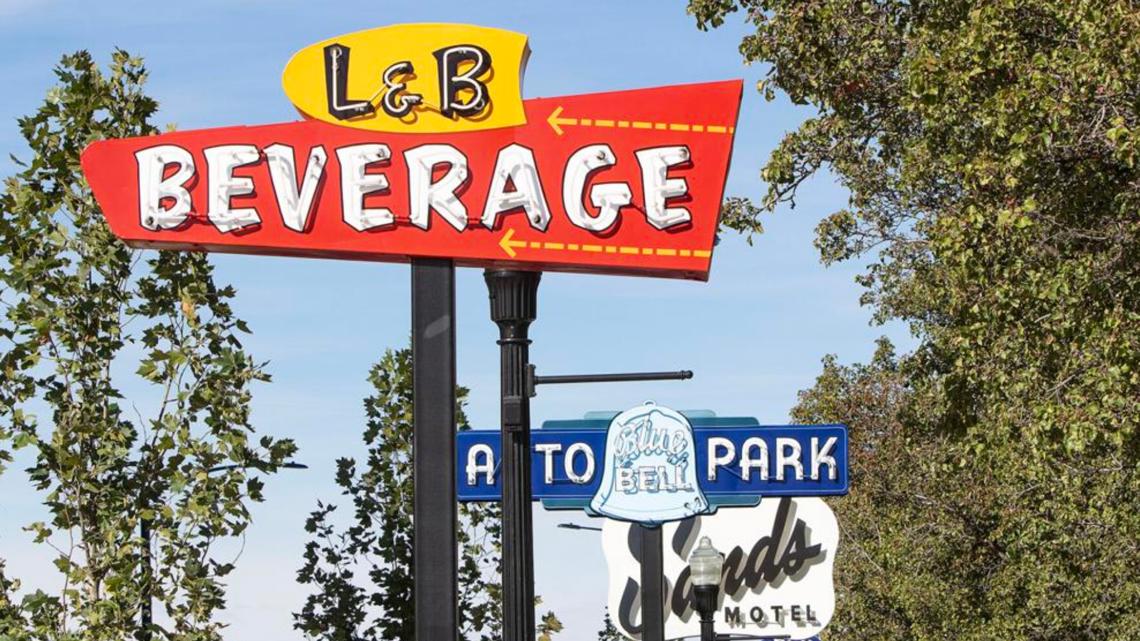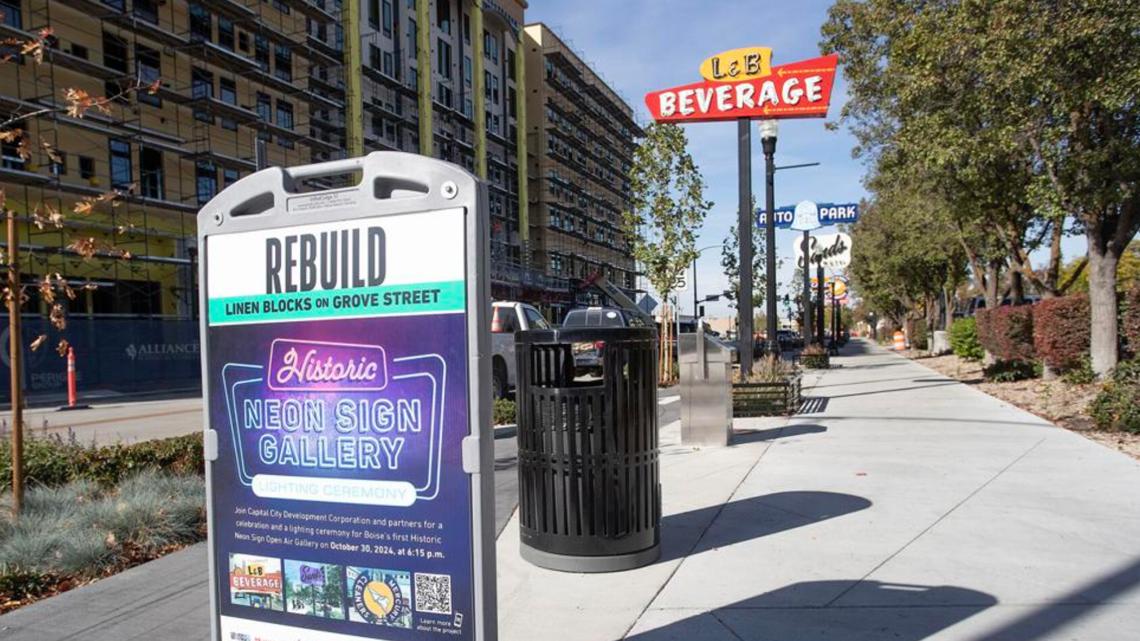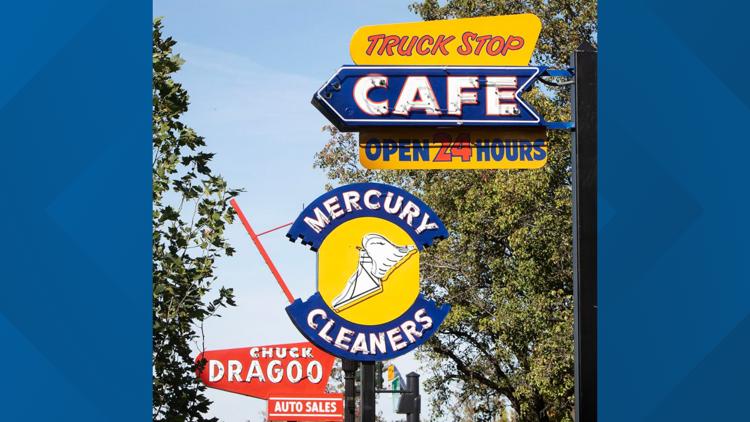BOISE, Idaho — This article originally appeared in the Idaho Press.
“When you collect big things, people notice,” Vangie Osborn, creator of the upcoming Signs of Our Times gallery, said.
In the very near future, one area of downtown Boise will start to look quite older — a few decades older, in fact. This won’t be a product of rapid dilapidation, however; instead, it will be in an effort to bring character to an area of Boise that has been lacking in color.
A total of six neon signs will be lit up at the end of the month along Grove Street, from 15th Street to 16th Street. Long-time residents of Boise will be able to recall some of the past businesses that once left their marks with their neon signage. The signs, which were the product of an extensive coordinated restoration campaign, all stem from Osborn’s personal collection that is now three decades in the making.
The collection was kicked off during Osborn’s time working for the Idaho Shakespeare Festival. She discovered a number of old, unused signs in a building downtown that was being used for the festival. The building manager offered the signs to Osborn, who accepted without any plans for what to do with them.
“They’re cool, but what do you do with them?” Osborn said. “And so I didn’t do anything.”
A conflation of factors, including Osborn living out of the country for some time, led to the signs lacking an opportunity for public viewing. Her eventual return to Boise, however, prompted her to start “seriously collecting,” she said.
Today, Osborn has amassed just shy of 40 signs, that range in height from a foot high to almost three stories tall. Multiple attempts have been made to get the signs restored and put on public display and various venues have been considered, including the Idaho State Museum and the present location of Freak Alley. While these ended up falling through due to logistical factors and other roadblocks, Osborn said that, above all else, she was looking for a location that would allow the signs to be permanently displayed.


In the fall of 2021, the Boise City Department of Arts and History, which previously coordinated with Osborn about a potential location for her signs, ultimately connected her with Capital City Development Corp, which presented an opportunity to permanently display some of her signs. With various buildings on the block, including the previous Linen Building, being reused and repurposed, CCDC was looking for an art installation that could match this aesthetic in an effort to revitalize Grove Street. After gathering community outreach on potential art installments, the community favored the idea of displaying restored neon signs from the city’s past, Amy Fimbel, CCDC’s senior project manager for the Grove Street redesign, said.
In the selection of what signs to use for the block, Fimbel said that CCDC was looking to use signs that were representative of what used to characterize the area. Recognizing the namesake of the Linen District, a Mercury Cleaners sign embodies the commercial laundry facility that once populated the area. Its function as an “auto-centric corridor” was represented by signs for Chuck Dragoo Auto Sales and Blue Bell Auto Park. The Sands Hotel sign, representing hospitality, recalls the area’s past function as temporary housing for migrant workers that were visiting the area in search of employment, Fimbel said.
With a home for Osborn’s signs finally found, the intensive restoration process could finally be kick-started.
A BIT ABOUT NEON
The restoration process was made possible in part through Osborn’s long-time relationship with Wil Kirkman, who is the owner of Rocket Neon, one of only a few in Idaho that does neon work full-time. The adoption of more cost-effective and energy-efficient LEDs was mostly what led the technology to fall into obscurity. Though a shrinking number of individuals possess the expertise to create the grand neon lighting arrangements that colored the previous decades, the 130-year-old process remains largely the same, Kirkman said.
“I’m sure if someone from a neon shop in 1930 saw mine, they would go, ‘oh, I know what all that is,’” Kirkman said.
The same two gasses are still used to provide the lights with their distinct color: argon and neon. Argon provides a blue color while neon provides an orange-red hue.
“Basically, it’s glass tubes with a powder coating on the inside, if they’re not clear,” Kirkman said. “That rare earth (powder) coating determines what the color is.”
BRINGING IT ALL TOGETHER
When it came to forming new neon lighting arrangements for Osborn’s signs, Kirkman said he used historical clues within the lighting to help restore them to their former glory. The process led him to work “non-stop for 90 days” to ensure that the project came together by the end of this month.


“It’s taken a lot of time out of my life for sure, but it’s been worth it,” he said. “I’ve seen them all lit up and they do look pretty fantastic.”
With a brand new coat of paint provided by Boise’s Classic Design Studios and structural refurbishments provided by custom sign company Yesco, the signs have been fully restored to their former glory. Well, almost their former glory. Osborn said that part of the charm of the lighting structures is their aged look. While most of the dents and bends have been removed, there are still indications of remaining wear to keep the individual character of the signs intact, Osborn said.
“When you try to make something perfect, all you do is create more problems,” Osborn said.
The official unveiling of the signs will take place on Oct. 30 at 6:15 p.m. There will also be a lighting ceremony as well as remarks from the partners involved regarding the efforts behind restoring the signs and the desire to bring a little more color to Grove Street. Following the ceremony, the signs will belong to Boise’s Department of Arts & History as part of their historic collection. Most notably, the commencement of the ceremony will bring a conclusion to Osborn’s years-long effort to find a home for some of the signs that occupy her collection.
“On the 30th, we’ll all be here, we’re going to turn them on, then they’re going to stay on permanently,” Osborn said.
This article originally appeared in the Idaho Press, read more on IdahoPress.com.



